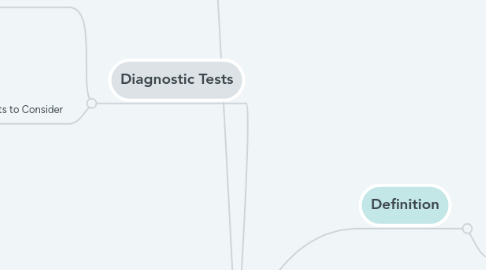Pancreatic Cancer
par MaryGrace Patel

1. -smoking -family history of pancreatic cancer -other hereditary cancer syndromes
2. Risk Factors
2.1. Strong
2.2. Weak
2.2.1. -chronic sporadic pancreatitis -diabetes mellitus -obesity -dietary factors
3. Diagnostic Tests
3.1. 1st Tests To Order
3.1.1. -abdominal ultrasound -pancreatic protocol CT -LFTs
3.2. Other Tests to Consider
3.2.1. -prothrombin time (PT) -CBC -cancer antigen (CA) 19-9 biomaker Positron emission tomography -endoscopic retrograde cholangiopancreatography (ERCP) -magnetic resonance cholangiopancreatography -endoscopic ultrasound -staging laparoscopy (with laparoscopic ultrasound) -biopsy
4. Treatment Options
4.1. Resectable (stages I and II) 1st ->surgical resection plus -> pancreatic enzyme replacement adjunct -> preoperative biliary stenting adjunct -> neoadjuvant radiation therapy or chemoradiation therapy
4.2. Locally advanced unresectable (stage III) 1st -> endoscopic stent insertion or palliative surgery plus -> chemotherapy or chemoradiation therapy or stereotactic body radiotherapy plus -> pain management + pancreatic enzyme replacement
4.3. metastatic (stage IV) 1st -> endoscopic stent insertion or palliative surgery plus -> chemotherapy plus -> pain management + pancreatic enzyme replacement
5. History & Exam
5.1. Key Factors
5.1.1. -jaundice -nonspecific upper abdominal pain or discomfort -weight loss and anorexia
5.2. Other Factors
5.2.1. -age: 65 to 75 years -steatorrhea -thirst, polyuria, nocturia, and weight loss -nausea, vomiting, anorexia, and -midepigastric pain -hepatomegaly -epigastric abdominal mass -positive Courvoisier sign -petechiae, purpura, bruising -Trousseau sign
6. Etiology
6.1. Pancreatic cancer is a disease of older people, with a peak incidence in people 65 to 75 years of age. The only consistently reported exogenous risk factor for pancreatic cancer is cigarette smoking. It is estimated that 5% to 10% of all pancreatic cancer patients have an inherited component. Inherited cancer syndromes associated with pancreatic cancer are hereditary pancreatitis, Peutz-Jeghers syndrome, familial atypical multiple mole melanoma, familial breast cancer syndrome, and hereditary nonpolyposis colorectal cancer syndrome
7. Definition
7.1. "Pancreatic cancer" refers to primary pancreatic ductal adenocarcinoma, which accounts for >85% of all pancreatic neoplasms. The course of pancreatic cancer has been shown to follow a linear progression model from preinvasive pancreatic intraepithelial neoplastic lesions to invasive ductal adenocarcinoma. Two additional well-defined precursor lesions are the intraductal papillary mucinous neoplasm and the mucinous cystic neoplasm.
8. Pathophysiology
8.1. About 65% of tumors are located within the head of the pancreas, 15% are in the body, 10% are in the tail, and 10% are multifocal. Characteristically, there is a strong desmoplastic stroma, which can account for >60% of the tumor mass. Lymph node metastases are common (40% to 75% of tumors <2 cm), as well as perineural and vascular invasion. Distant metastases are usually found in liver, lung, skin, and brain. Molecular and histopathologic analyses have identified 3 distinct precursor lesions: pancreatic intraepithelial neoplasia (PanIN), intraductal papillary mucinous neoplasm, and mucinous cystic neoplasm. PanINs are the microscopic precursor lesions (<5 mm), defined as neoplastic epithelial proliferations in the small pancreatic ducts, and are classified as PanIN-1, PanIN-2, or PanIN-3, based on their degree of differentiation. The progression from normal epithelium to invasive carcinoma has been proposed to follow a linear progression model, associated with accumulation of genetic alterations. Early genetic alterations include telomere shortening and mutations in the KRAS2 oncogene (occurring in >90% of early PanIN lesions), followed by inactivation of the p16/CDKN2A tumor suppressor gene and late alterations including inactivation of the TP53 and SMAD4 tumor suppressor genes.
9. Common Findings
9.1. -Pancreatic cancer is the third most common cause of cancer-related death in the US. -Most common presentation is at 65 to 75 years of age with painless obstructive jaundice and weight loss. Generally presents late with advanced disease. -Surgical resection offers the only hope for cure. Chemotherapy and radiation therapy, as primary treatment modalities, produce a small but statistically significant benefit. Adjuvant chemotherapy prolongs survival. -Only a minority (5% to 10%) of patients can undergo potentially curative surgery: these patients have a 5-year survival of up to 22%, which decreases to <2% in the presence of distant metastasis. -Patients with metastatic disease (50% to 55%) have a limited survival of only 3 to 6 months.


